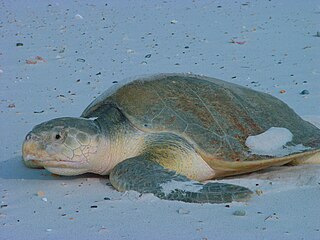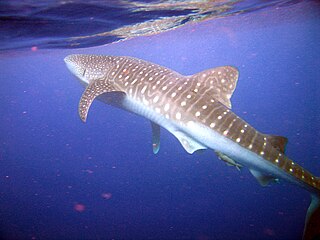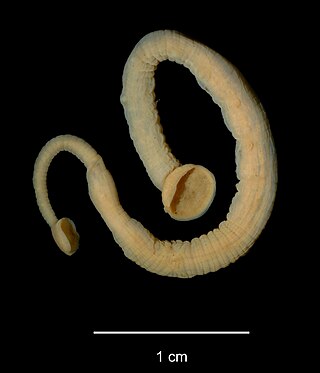
Sea turtles, sometimes called marine turtles, are reptiles of the order Testudines and of the suborder Cryptodira. The seven existing species of sea turtles are the flatback, green, hawksbill, leatherback, loggerhead, Kemp's ridley, and olive ridley. Six of the seven sea turtle species, all but the flatback, are present in U.S. waters, and are listed as endangered and/or threatened under the Endangered Species Act. All but the flatback turtle are listed as threatened with extinction globally on the IUCN Red List of Threatened Species. The flatback turtle is found only in the waters of Australia, Papua New Guinea, and Indonesia.

Turtle fibropapillomatosis (FP) is a disease of sea turtles. The condition is characterized by benign but ultimately debilitating epithelial tumours on the surface of biological tissues. FP exists all over the world, but it is most prominent in warmer climates, affecting up to 50–70% of some populations.

Cheloniidae is a family of typically large marine turtles that are characterised by their common traits such as, having a flat streamlined wide and rounded shell and almost paddle-like flippers for their forelimbs. They are the only sea turtles to have stronger front limbs than back limbs. The six species that make up this family are: the green sea turtle, loggerhead sea turtle, olive ridley sea turtle, hawksbill sea turtle, flatback sea turtle and the Kemp's ridley sea turtle.

The olive ridley sea turtle, also known commonly as the Pacific ridley sea turtle, is a species of turtle in the family Cheloniidae. The species is the second-smallest and most abundant of all sea turtles found in the world. L. olivacea is found in warm and tropical waters, primarily in the Pacific and Indian Oceans, but also in the warm waters of the Atlantic Ocean.

The loggerhead sea turtle is a species of oceanic turtle distributed throughout the world. It is a marine reptile, belonging to the family Cheloniidae. The average loggerhead measures around 90 cm (35 in) in carapace length when fully grown. The adult loggerhead sea turtle weighs approximately 135 kg (298 lb), with the largest specimens weighing in at more than 450 kg (1,000 lb). The skin ranges from yellow to brown in color, and the shell is typically reddish brown. No external differences in sex are seen until the turtle becomes an adult, the most obvious difference being the adult males have thicker tails and shorter plastrons than the females.

Kemp's ridley sea turtle, also called commonly the Atlantic ridley sea turtle, Kemp's ridley turtle, and Kemp's ridley, is a species of turtle in the family Cheloniidae. L. kempii is the rarest species of sea turtle and is the world's most endangered species of sea turtle. It is one of two living species in the genus Lepidochelys. The species L. kempii primarily occupies habitat around the Gulf of Mexico, though its migrations into the Atlantic Ocean are being affected by rising temperatures. Kemp's ridley sea turtle is listed as endangered under the Endangered Species Act (ESA), and conservation efforts are attempting to rebuild population numbers. Human activity, including but not limited to habitat destruction, climate change, and oil spills, threaten populations.

The green sea turtle, also known as the green turtle, black (sea) turtle or Pacific green turtle, is a species of large sea turtle of the family Cheloniidae. It is the only species in the genus Chelonia. Its range extends throughout tropical and subtropical seas around the world, with two distinct populations in the Atlantic and Pacific Oceans, but it is also found in the Indian Ocean. The common name refers to the usually green fat found beneath its carapace, due to its diet strictly being seagrass, not to the color of its carapace, which is olive to black.

The Australian flatback sea turtle is a species of sea turtle in the family Cheloniidae. The species is endemic to the sandy beaches and shallow coastal waters of the Australian continental shelf. This turtle gets its common name from the fact that its shell has a flattened or lower dome than the other sea turtles. It can be olive green to grey with a cream underside. It averages from 76 to 96 cm in carapace length and can weigh from 70 to 90 kg. The hatchlings, when emerging from nests, are larger than other sea turtle hatchlings when they hatch.

Rhynchobdellida, the jawless leeches or freshwater leeches, are an order of aquatic leeches. Despite the common name "freshwater leeches", species are found in both sea and fresh water. They are defined by the presence of a protrusible proboscis instead of jaws, and having colourless blood. They move by "inchworming" and are found worldwide. The order contains 110 species, divided into 41 genera and three families. Members of the order range widely in length, usually between 7 and 40 mm. They are hermaphrodite. The order is not monophyletic.

Cayo Costa State Park is a state park in the U.S. state of Florida, on Cayo Costa, an island directly south of Boca Grande and just north of North Captiva Island, approximately 12 miles (19 km) west of Cape Coral. The park is accessible only by charter boat, private boat, ferry or helicopter.

Histioteuthis reversa, commonly known as the reverse jewel squid or the elongate jewel squid, is a species of cock-eyed squid, so called because the eyes are dissimilar. It occurs at moderate depths in the Atlantic Ocean and the Mediterranean Sea. It is also known from the Indian Ocean.

The hawksbill sea turtle is a critically endangered sea turtle belonging to the family Cheloniidae. It is the only extant species in the genus Eretmochelys. The species has a global distribution that is largely limited to tropical and subtropical marine and estuary ecosystems.

Canthigaster rostrata, commonly known as the Caribbean sharp-nose puffer, is a pufferfish from the Western Central Atlantic. The Caribbean sharp-nose puffer is a small fish with a maximum length of 12 cm or approximately 4.7 inches. It can be encountered from the coast of South Carolina to Venezuela, including Bermuda, the Gulf of Mexico, and in the Caribbean Sea. They can live up to 10 years in the wild, females typically live longer due to aggressive male territory behavior. The Caribbean sharp-nose puffer is a highly toxic species of marine fish due to the presence of tetrodotoxin in its tissues and organs. Despite its toxicity, the sharp-nose pufferfish occasionally makes its way into the aquarium trade.

The whitefin sharksucker or short-disk sharksucker, is a species of remora native to subtropical waters of the western Atlantic Ocean, Gulf of Mexico and Caribbean Sea. This fish can reach a length of 75 centimetres (30 in) TL though most fish do not exceed 50 centimetres (20 in) TL. It can be free-swimming, or can attach itself to a host fish or turtle by means of a sucker on the back of the head.

Turtle leeches are a genus, Ozobranchus, of leeches (Hirudinea) that feed exclusively on the blood of turtles. Only two species—Ozobranchus margoi and Ozobranchus branchiatus—are found in the Atlantic coast of the United States and the Gulf of Mexico. Little is known about these leeches due to difficulties in studying their sea turtle hosts.

The flora and fauna of Honduras reflects the country's geographical location inside the tropics. This has allowed for diverse species of plants and animals to be adapted, but some of them are now in danger of extinction. This has posed the Honduran government, offices and nature organizations to look after the protection of the local environment, like the creation of nature reserves.

Chelonibia testudinaria is a species of barnacle in the family Chelonibiidae. It is native to the Atlantic Ocean, Mediterranean Sea and Gulf of Mexico where it lives as a symbiont on sea turtles, being particularly abundant on the loggerhead sea turtle.

Pontobdella muricata is a species of marine leech in the family Piscicolidae. It is a parasite of fishes and is native to the northeastern Atlantic Ocean, the Baltic Sea, the North Sea, and the Mediterranean Sea.

Trachelobdella lubrica is a species of marine leech in the family Piscicolidae. It is a parasite of fish and has a worldwide distribution in the equatorial belt. It was first described in 1840 by the German zoologist Adolph Eduard Grube, the type locality being Palermo, Sicily, in the Mediterranean Sea.



















